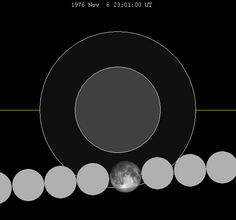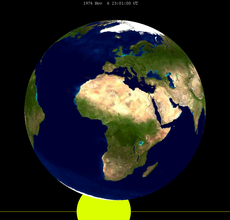November 1976 lunar eclipse
| Penumbral eclipse | |||||||||
| Date | 6 November 1976 | ||||||||
|---|---|---|---|---|---|---|---|---|---|
| Gamma | −1.12706 | ||||||||
| Magnitude | 0.83827 | ||||||||
| Saros cycle | 145 (9 of 71) | ||||||||
| Penumbral | 265 minutes, 52.1 seconds | ||||||||
| |||||||||
A penumbral lunar eclipse took place on Saturday, November 6, 1976, the second of two lunar eclipses in 1976, the first being on May 13. This subtle penumbral eclipse may have been visible to a skilled observer at maximum eclipse. 83.827% of the Moon's disc was partially shaded by the Earth (none of it was in total shadow), which caused a gentle shadow gradient across its disc at maximum; the eclipse as a whole lasted 4 hours, 25 minutes and 52.1 seconds. Occurring only 0.3 days after apogee (Apogee on Saturday, November 6, 1976), the Moon's apparent diameter was 6.5% smaller than average.[1]
Saros series[edit]
This is the 9th member of Lunar Saros 145. The previous event was the October 1958 lunar eclipse. The next event is the November 1994 lunar eclipse. Solar Saros 152 interleaves with this lunar saros with an event occurring every 9 years 5 days alternating between each saros series.
Eclipse season[edit]
This event followed the Total solar eclipse of October 23, 1976.
Visibility[edit]
The eclipse was visible over Americas, Europe, Africa, Asia and Australia, seen rising over Americas and setting over Asia and Australia.
-
Chart of Moon's path through the Earth's shadow
-
The orientation of the Earth as viewed from the center of the Moon during greatest eclipse
Related lunar eclipses[edit]
Eclipses in 1976[edit]
- An annular solar eclipse on Thursday, 29 April 1976.
- A partial lunar eclipse on Thursday, 13 May 1976.
- A total solar eclipse on Saturday, 23 October 1976.
- A penumbral lunar eclipse on Saturday, 6 November 1976.
Lunar year series[edit]
| Lunar eclipse series sets from 1973–1976 | ||||||||
|---|---|---|---|---|---|---|---|---|
| Ascending node | Descending node | |||||||
| Saros | Date Viewing |
Type Chart |
Gamma | Saros | Date Viewing |
Type Chart |
Gamma | |
| 110 | 1973 Jun 15
|
Penumbral
|
−1.32166 | 115 | 1973 Dec 10
|
Partial
|
0.96441 | |
| 120 | 1974 Jun 04
|
Partial
|
−0.54887 | 125 | 1974 Nov 29
|
Total
|
0.30540 | |
| 130 | 1975 May 25
|
Total
|
0.23674 | 135 | 1975 Nov 18
|
Total
|
−0.41343 | |
| 140 | 1976 May 13
|
Partial
|
0.95860 | 145 | 1976 Nov 06
|
Penumbral
|
−1.12760 | |
| Last set | 1973 Jul 15 | Last set | 1973 Jan 18 | |||||
| Next set | 1977 Apr 04 | Next set | 1977 Sep 27 | |||||
Half-Saros cycle[edit]
A lunar eclipse will be preceded and followed by solar eclipses by 9 years and 5.5 days (a half saros).[2] This lunar eclipse is related to two total solar eclipses of Solar Saros 152.
| November 2, 1967 | November 12, 1985 |
|---|---|

|

|
Tzolkinex[edit]
- Preceded: Lunar eclipse of September 25, 1969
- Followed: Lunar eclipse of December 20, 1983
See also[edit]
Notes[edit]
- ^ Hermit Eclipse: Saros cycle 145
- ^ Mathematical Astronomy Morsels, Jean Meeus, p.110, Chapter 18, The half-saros
External links[edit]
- 1976 Nov 06 chart Eclipse Predictions by Fred Espenak, NASA/GSFC


